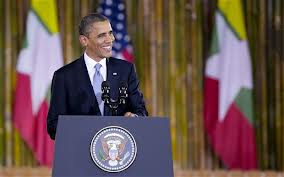“The Political Prisoners Game”
By Burma Partnership • November 19, 2012 As US President Barack Obama visited Burma today, the Thein Sein government continues to pursue positive headlines in a cynical move to release political prisoners at the same time as Obama’s arrival.
As US President Barack Obama visited Burma today, the Thein Sein government continues to pursue positive headlines in a cynical move to release political prisoners at the same time as Obama’s arrival.
Last Thursday’s release of 452 prisoners was a huge disappointment as no political prisoners were among them, with the Assistance Association for Political Prisoners calling it “the worst amnesty ever”. Today, 19 November, however, at the time of publication 45 political prisoners have been released. This ploy by the government usually coincides with a visit of an international figure or a decision made by the international community on Burma. In September, 87 political prisoners were released the week before President Thein Sein went to New York for the UN General Assembly. In July, 25 political prisoners were released shortly before the US lifted its investment ban and Thein Sein met with US Secretary of State, Hillary Clinton, in Cambodia. This time, it is because President Obama is coming to Burma. “It seems there is a new game in Burma, which is the political prisoners game,” Phil Robertson from Human Rights Watch stated, highlighting the lack of integrity of these releases.
This public relations game is being further played with the beautification of Rangoon University. Historically very important as a centre of democratic opposition and student resistance, its physical condition has deteriorated dramatically since it was put into disuse in the 1990’s by the military regime. Thus, President Obama’s decision to make his speech there is highly symbolic and the government is desperately trying to put a new face on the university, painting buildings and clearing rubbish from its grounds. This is a kick in the face for those activists arrested in July who were planning a protest at the location of the student union building to mark 50 years since it was bombed by the army. It seems that when international attention is on Burma, the student union building is presented as an indictor of progress. But the hastily put up façade is a symbol of the depth of Burma’s reforms so far. If the student union building was a functioning, working institution, where students were allowed to gather and exchange views freely, this would be a real marker of progress.
If the government were serious about releasing political prisoners, they would have all been released by now. There are some positive signs from the government with the announcement that the International Committee for the Red Cross (ICRC) will be allowed greater access to assess the conditions inside Burma’s prisons as well as the intention to create review mechanism of prisoners deemed to be political. While this is encouraging it is wise to retain an element of caution. It has been over 18 months since Thein Sein started the reforms but there are still around 200 political prisoners in Burma. Furthermore, this review mechanism will only be effective and legitimate if it includes substantial involvement of non-government affiliated parties such as former political prisoners and organisations that work to help political prisoners. It is unclear if this will be implemented. A fundamental concern is that the only time this government seems to think of political prisoners is when Burma is in the spotlight and the government has something to gain from the international community.
Tags: Burma Partnership, Political Prisoners, United States, US President Barack ObamaThis post is in: Blog
Related PostsBurma Partnership Celebrates Continuing Regional Solidarity for Burma and Embraces the Work Ahead for Progressive Voice
Burma Army Displays Blatant Disregard for 21st Century Panglong Peace Process
Ann Din Coal Power Plant: Local Movement and Action to Preserve and Protect Natural Resources and Land: Mon IDP Report Case Study #4
Latest Human Rights Abuse Case Demonstrates Urgent Need to Reform the Myanmar National Human Rights Commission
Human Rights Far From Guaranteed as US Sanctions on Burma Are Removed









 All posts
All posts